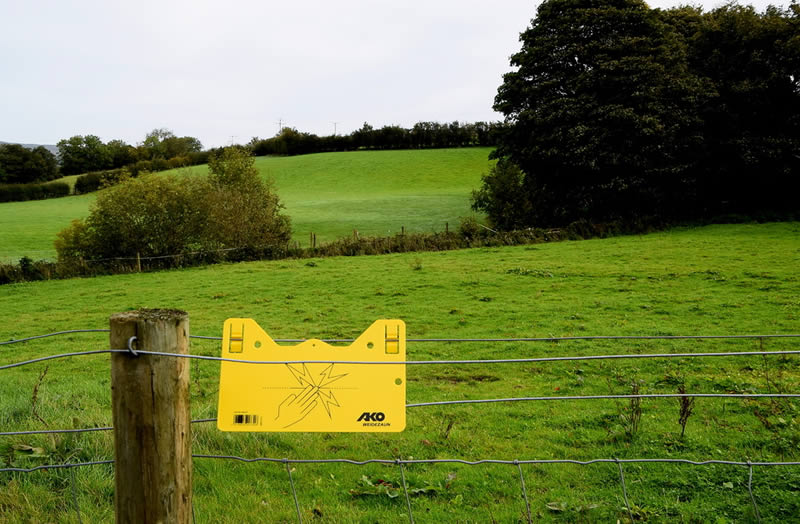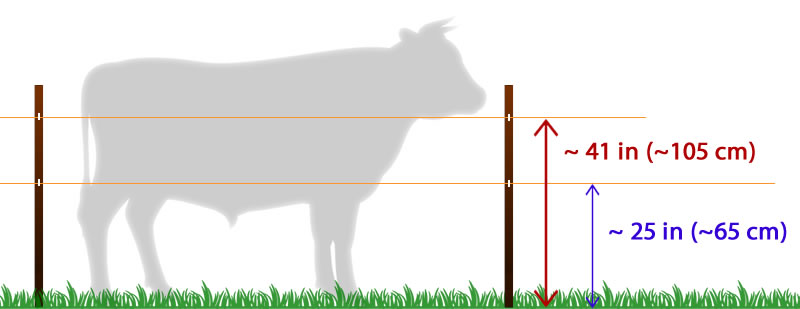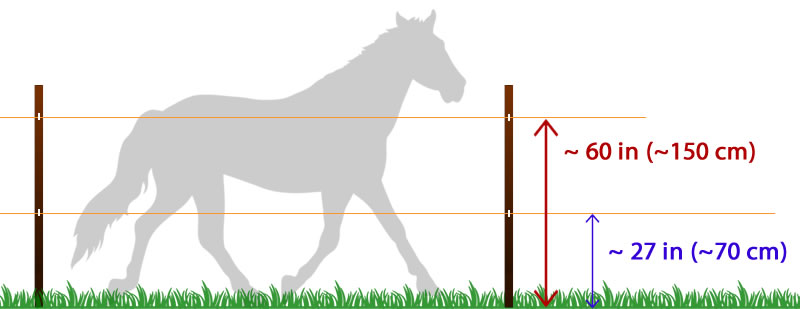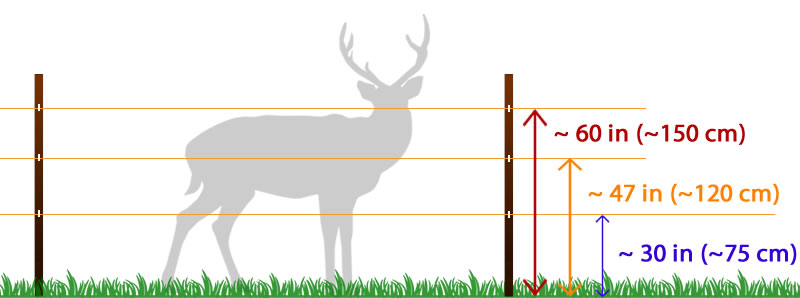The electric fence is of great help to any farmer. It fulfills several roles:
- keeping animals safe by protecting them from predators
- helping to manage the pastures, confiding the animals in a specific delimited area
- eliminating continuous surveillance of animals
Furthermore, the advantages of installing an electric fence exceed those of a usual one. The electric fence is much easier to install and maintain, is much more durable because the animals will learn to respect it, and is very easy to disassemble and move to a new location.
When installing electric fences, you should ask yourself the following questions before starting and before procuring certain equipment:
What type of animals will you confine?
The type of animals you have decided to confine will determine the type of equipment you will need. You have to consider the size of the animal, its strength, jumping ability, hair length, and skin thickness.
What is the main function of the electric fence?
The electric fence can be used to keep the animals in a specially delimited place but also to protect your animals against predators.
What length will the electric fence have to be?
The length of the fence is another factor that will influence the amount of the necessary materials, such as the number of posts, as well as the power of some equipment, such as the electric fence energizer.
Is your soil quality good for installing an electric fence?
The soil must have certain qualities for an electric fence to work properly. If the soil is poor in properties or too dry it will affect the conductivity of the fence. Poor grounding is one of the biggest and most common issues of an electric fence.
Contents
- The Electric Fence Kit – Parts and Components
- Electric Fence Energizer
- Solar-Powered Fence Charger
- Electric Fence Wire, Rope, and Tape
- Galvanized Electric Fence Wire
- Electric Fence Netting
- Electric Fence Insulators
- Electric Fence Gate
- Electric Fence Posts
- Electric Fence Connectors
- Electric Fence Lead Out Cable
- Electric Fence Grounding Rod/ Electric Fence Earth Stakes
- Electric Fence Tensioners/Electric Fence End Strainers
- Electric Fence Testers
- Electric Fence For Cattle
- Electric Fence For Bulls
- Electric Fence For Horses
- Electric Fence For Sheep
- Electric Fence For Goats
- Electric Fence For Pigs
- Electric Fence For Wild Boars
- Electric Fence For Deers
- Electric Fence For Hart Deers
- Electric Fence For Bears
- Electric Fence For Dogs
The Electric Fence Kit – Parts and Components
To install an electric fence you need several components. The components can be purchased one by one, but there are also complete electric fence kits on the market for installing the electric fence. In general, an electric fence kit contains the electric fence energizer, electric wires, insulators, gate accessories, and warning plate, but not the ground bar and fence posts.
In the following rows, you will find the list of materials needed for the construction and installation of an electric fence.
Electric Fence Energizer
The main component of an electric fence is the electric fence energizer. This is responsible for creating high-voltage pulses along the entire length of the electric fence. At the same time, it also controls the tension on the entire surface of the fence.
The energy of the pulses generated by the electric fence energizer is usually measured in Joules (J). It can be found in different models and also with different powers. There are energizers that can generate only 5 Joules and others that can deliver 20 Joules. However, the device must be chosen according to the animals that will be fenced. If the animal has shorter hair, you can get a generator with lower power, and if the animal has fur, you can choose a stronger one.
Solar-Powered Fence Charger
To generate impulses, the electric fence energizer must be supplied with a 12 V direct current. Of course, you can connect the fence to a classic power source, but using solar recharging systems is a more sustainable and cheaper choice in the long term.
You can choose a solar recharging system with battery gel or acid. Some of them include LED lighting systems powered by solar panels as well.
Electric Fence Wire, Rope, and Tape
Wire, rope, or tape are conductors used to make an electric fence. All three are made of plastic threads and metal inserts. They have the same electrical resistance and tear resistance properties.
The differences between them are the following: the electric fence rope is thicker than the wire, having a higher breaking resistance. Electric fence tape is a good choice when you want the electric fence to have good visibility.
Tear strength is expressed in lbs/kg, so for stronger animals, you must choose a wire, rope, or tape with a value over 220 lbs (100kg), and for smaller animals, a value below or a maximum of 220 lbs (100 kg) is perfect.
Finally, you must also take into account the electrical resistance. This must be as small as possible because the energy loss will also be lesser, and you can use that wire or rope to make a longer fence.
Galvanized Electric Fence Wire
If you are thinking of installing a permanent electric fence, use galvanized electric fence wire because, thanks to its properties, it is much more resistant to rust and corrosion, and you can use it for extremely long fences, even tens of miles/km long. Its properties are tear resistance and electrical resistance. Keep in mind that this galvanized wire has extremely low visibility due to its small diameter.
Electric Fence Netting
Electric fence netting is ideal for animals such as poultry, goats, dogs, and even pigs. It is not recommended for chickens, ducklings, or piglets because they can get through the fence net.
Electric Fence Insulators
Insulators have the role of preventing various incidents. They act by isolating components such as live wires, which present a risk of touching something conductive that would cause a short circuit. In case of a short circuit, the fence becomes totally ineffective.
There are many electrical fence insulators that can be classified according to:
- the type of conductor used:
- insulators for wooden posts
- insulators for steel posts
- insulators for metal posts
- the mounting method:
- insulators with nails
- screw-in insulators
- their role:
- corner insulators for the electric fence’s corners
- gate insulators for gate construction
- general insulators for intermediate posts
Electric Fence Gate
The gate of an electric fence is made up of several elements and it is preferable to buy them all as a set. But if you prefer to make a gate from scratch, you will need the following: a plastic handle to protect you against electric shocks, one or more insulators to keep the wires, tapes, or ropes as firm as possible, and a spring for easy opening and closing the gate.
Electric Fence Posts
The posts are significant components of the electric fence system. They have the role of supporting the wires while offering increased resistance to the fence. What kind of posts you need depends on what type of fence you want to build. If you make a temporary electric fence, you can use plastic posts because they can be moved easily. If you want to get a permanent electric fence, you can use wood or steel posts.
Electric Fence Connectors
If the joining or fixing of the wires is not done properly then the electric fence becomes ineffective. The connectors will provide good functionality for the electric fence. The connectors are available in different sizes that depend on the wire’s diameter.
There are three types of connectors that can be used to mount the electric fence: the end or extension connectors, the gate connector, which includes a ring and a screw connector that links the gate handles to the fence’s wire or rope, and the tape connector that does not let the tape to distort.
Electric Fence Lead Out Cable
The electric fence lead-out cable is also called underground cable due to the fact that it conducts the high voltage of the fence under or sometimes over the ground. Being well insulated, the cable does not deteriorate over time and ensures connectivity between the generator and the fence.
If this cable will be installed underground, then you can use an extra hose or plastic pipe for increased protection.
Electric Fence Grounding Rod/ Electric Fence Earth Stakes
The electric fence quality depends on the grounding process. You must pay attention to which galvanizing metal bar you choose. If the fence is short, then you can purchase a bar with a length of 1 m, but if you plan to make a longer one of up to 6 mi (10 km), then you need several galvanizing metal bars, and they should be located at a distance of 2 m.
Soil quality is important in an electric fence system because the fence energizer circuit closes through the ground. If the soil where the bar is planted is dry, then this will lead to poor conductivity. You can solve this problem by building a drip system to maintain soil moisture.
Electric Fence Tensioners/Electric Fence End Strainers
It’s important to use tensioners when installing your electric fence. Tensioners are assembled at the ends of wires, wires, or tapes and have the role of maintaining the tension on the conductors. Tensioners can be easily adjusted with the help of a fixed key.
Electric Fence Testers
The tester is an indispensable element that will help you monitor the functionality of your fence and quickly discover possible breaks or grounding issues.
Electric Fence For Cattle
If you raise cattle on your farm, below you will find all the details for installing an electric fence for these animals.
Electric fence energizer
In the case of cattle, you can purchase an electric fence energizer with a maximum power of 3-4 Joules. Cattle are short-haired animals and do not need a greater pulse.
Conductor
Cattle are fairly massive animals and can reach quite a high speed, therefore it is recommended to use a rope, wire, or fence tape of 0.39 in (10 mm) or thicker, with medium or high breaking strength. Another possibility would be to use visible tape.
Fence
The height of the electric fence for cattle must be 35 in (90 cm). Therefore, the first row of thread will be arranged at 24 in (60 cm), while the second at 35 in (90 cm). The fence posts must be extremely resistant and should be placed at a distance of 23 ft to 26 ft (7 to 8 m) from each other.
The fence posts must be high enough with half of their height sunk into the ground. So, if your posts are 8 ft (2.4 m) long, 4 ft (1.2 m) should stick out of the ground.
Electric Fence For Bulls
Electric fence energizer
Bulls are generally some of the most aggressive livestock and extremely strong at the same time. But, due to the fact that they have relatively short hair, an electric fence energizer of 3-4 Joules is enough.
Conductor
Considering that an adult bull weighs between 1,100 and 2,200 lbs (499 and 997 kg), you must use a high-resistance conductor. The rope, wire, or fence tape used must be at least 0.39 in (10 mm).
Fence
The electric fence for bulls can be built with two wires. The first wire should be placed at 25 in (65 cm), while the second wire can be at 41 in (105 cm). The fence posts must have high resistance. The most suitable would be the posts made of solid wood. However, if you know that your bulls are very aggressive, you can use up to 5-6 wires for the fence.
Electric Fence For Horses
Electric fence energizer
Horses are peaceful, intelligent animals and easy to control with an electric fence. Also, horses have thin hair, and it is sufficient to use an electric fence energizer of a minimum of 2 to a maximum of 4 Joules.
Conductor
Horses are massive and even very fast animals and that is why an electric fence rope, or electric fence tape of at least 0.78 (20 mm) must be used.
Fence
An electric fence with only two rows of wires is sufficient for horses. Since the horse is taller, the first rope of the electric fence can be placed at 27 in (70 cm)and the second at 60 in (150 cm). The wooden posts can be placed at a maximum distance of 23 ft (7 m) between them.
Electric Fence For Sheep
Electric fence energizer
The sheep is a domestic animal that is known for its fur. Because it has longer and denser hair, an electric fence energizer capable of generating a minimum of 4 Joules is needed.
Conductor
The sheep do not have an aggressive character and do not weigh much, as an adult can reach a weight between 165 and 330 lbs (75 and 150 kg). So, it is sufficient to use an electric fence wire with medium tear strength.
Fence
For sheep, you can use two wires of electric fence. The first wire will be placed at 14 in (35 cm) and another at 30 in (75 cm), and the fence posts can have a distance of up to 26 ft (8 m) between them.
Electric Fence For Goats
Electric fence energizer
Goats are animals with very thick fur that will protect them from electric shocks. The electric fence energizer for sheep must have an average power of about 4 Joules.
Conductor
A wire conductor with a breaking strength of less than 220 lbs (100 kg) is ideal for goats.
Fence
Goats love freedom and are difficult to keep in a defined space. They love to walk in new places, and that’s why they will try to sneak out. That is why an ideal electric fence for goats consists of 4 wires. These wires can be placed at the following heights: 10 in, 20 in, 30 in, and 40 in (25 cm, 50 cm, 75 cm, and 100 cm) from bottom to top.
Electric Fence For Pigs
Electric fence energizer
Pigs are easy to control and intelligent animals, which will learn quickly the limit imposed by the electric fence. Moreover, they have relatively short hair, which makes an electric fence energizer with a power of 3-4 Joules good enough.
Conductor
When it comes to the conductor, you can choose between two options: an electric fence wire with low or medium tear resistance, or an electric fence tape with a width of 0.39-0.78 in (10-20 mm).
Fence
Since the pig tends to root, it is recommended that the first wire be placed at 10 in (25 cm) and the second at 25 in (65 cm) from the ground. The fence posts can be placed at a maximum distance of 20 – 23 ft (6 – 7 m).
Electric Fence For Wild Boars
Electric fence energizer
Wild boars can be successfully controlled with an electric fence. They have quite long hair, and therefore the electric fence energizer must be at least 4 Joules. Moreover, wild boars need a larger area to be fenced.
Conductor
It is recommended to use a conductor with low electrical resistance and high tear resistance. A wire of 0.12 to 0.24 in (3 to 6 mm) thickness can be used, or even a strip of 0.79 in (20 mm) width.
Fence
The height of the fence is similar to the fence of the domestic pig: one wire at 10 in (25 cm) and another at 25 in (65 cm).
Electric Fence For Deers
Electric fence energizer
To build an electric fence for deer, you can choose an electric fence energizer with a power of 4 to 7 Joules.
Conductor
The materials used in the construction of the electric fence for deer will be wires or ropes with low electrical resistance and high tear strength.
Fence
A fence constructed of three rows of wire is necessary for deer. The first wire will be 23 in (60 cm) from the ground, the second at 35 in (90 cm), and the last at 47 in (120 cm).
Electric Fence For Hart Deers
Electric fence energizer
For the correct construction of an electric fence for hart deers, you must purchase a 7 Joule electric fence energizer. They have short but rather thick fur.
Conductor
A characteristic of deer is their size, they are massive and weigh up to 661 lbs (300 kg) at maturity. So, you will need a 0.24 in (6 mm) thick electric fence wire or rope.
Fence
For hart deer, the electric fence must have a height of 60 in (150 cm). You can use up to 3 horizontal wires. The bottom wire can be placed at a height of 30 in (75 cm) from the ground, while the middle one at 47 in (120 cm).
Electric Fence For Bears
Electric fence energizer
The bear is a strong animal with quite thick fur that needs a powerful electric fence energizer of at least 7 Joules.
Conductor
Considering that an adult bear can reach around 300 to 860 lbs (135 to 390 kg), it is advisable to use electric fence rope as thick as possible (0.23 in, 6 mm) with a high tear strength.
Fence
As poles, you can use solid wood poles or even iron pipes set at a maximum distance of 16 ft (5 m). You can use three wires placed at 10 in, 24 in, and 37 in (25cm, 60cm, and 95cm), measured from the ground.
Electric Fence For Dogs
Electric fence energizer
For fencing the dogs, we must take into account the breed of the dogs. Some breeds of dogs have short hair and need an electric fence energizer of about 1-2 Joules, while breeds with longer hair require one capable of generating 2-4 Joules.
Conductor
Dogs are fast animals but not extremely strong, so an electric fence wire with a tear strength of around 220 lbs (100 kg) is ideal.
Fence
As with the fence energizer, the breed of the dogs and their size must also be taken into account with the fence. A fence with three wires located at 4 in, 10 in, and 18 in (10 cm, 25, and 45 cm) from the ground is recommended. The first wire (4 in, 10 cm) can be omitted if small dogs will not be fenced. If the dogs are of a larger size, the last wire from 18 in (45 cm) can be adapted and high up to 20 -24 in (50-60 cm).
In general, this is what you need to install an electric fence. If you think we missed something or if you have other suggestions, please leave us a comment and share them with the community.













